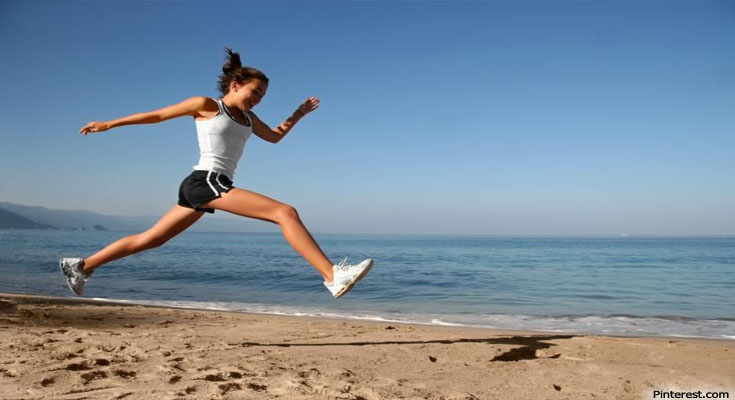In this article, you will read about the different exercise activities you can do to start your journey to a fitter and slimmer you. You will also get top tips about the exercises.
Hiking
Hiking on trails and tracks or up a hill is much more fun than pounding the pavements. It is also a massive calorie burner (up to 500 calories per hour) and the varying terrain improves your fitness quicker than walking on the flat.
Wear several thin layers – comprising modern wicking fabrics such as Cool-Max for maximum coolness – rather than one thicker layer. In hot weather wear loose lightweight clothing that is sweat permeable and light-colored. Do not struggle uphill wearing waterproof clothing.
Take a hat to prevent heat loss in the winter, and to protect your head from the sun and prevent overheating in the summer. Walking boots or shoes with molded grip-giving soles are a must if the ground is at all hilly or rough. Fitting should be snug but not overtight (you should be able to wiggle your toes without them touching the front of the boot).
Top hiking tips:
Keep your neck and shoulders relaxed. Look forwards rather than down.
Keep your arms tucked in close to your body.
Concentrate power in your back leg and foot as you push off the ground.
Find a comfortable stride length – keep it short so you won’t rotate through the hips.
Hold your abdominals tight to keep your torso stable and strong.
Keep your knees and feet aligned – your feet should point directly forwards.
Cycling
Cycling – get on your bike for a calorie-burning ride. It improves your heart and lungs, burns fat (450 calories per hour), tones the muscles in your thighs, buttocks, and lower legs, and strengthens the lower back and stomach muscles. Cycling to and from work or the shops integrates exercise into your daily activities, while cycling for fun is a great way to explore the countryside.
Always wear a well-fitting helmet – test this by putting the helmet on and shaking your head. It should not flop around or fall forwards.
If you have knee problems, make sure the seat is high enough and the tension is low – keep in a lower gear.
If you have back trouble, avoid bending forwards in the saddle. Cycling on an indoor bike, which is more upright, should relieve the strain.
For maximum fat-burning, aim to maintain a brisk pedaling cadence, between 80 and 110rmp – use lower gears or reduce the tension on an indoor bike. For best muscle tone, use a higher gear or increase the tension. You’ll need to drop your pedaling cadence between 60 and 90rmp.
Off-road cycling requires more upper-body strength and greater balance than road cycling. However, the rewards are a traffic-free environment and more interesting scenery.
Top cycling tips:
Check your saddle height – in the downward phase of cycling action, your leg should be extended but bent very slightly at the knee.
Keep your neck and shoulders relaxed – avoid tensing your shoulders; ensure there is a good distance between your ears and shoulders.
Keep a neutral spine position in the saddle – keep as upright as possible and don’t allow your back to slump forwards.
Hold your stomach muscles tight – this will help to stabilize you.
Your toes should point downwards slightly as you push down – this prevents tension in the calf muscles.
Use toe clips – this allows you to use the muscles at the front and back of your legs to power the movement. Without clips, only the muscles at the front of the legs get worked.
Running
Running is one of the simplest ways to get fit – there’s no special equipment or membership fees and, even if you are very busy, you can fit it into your schedule. It tones your thighs, hips, calves, and buttocks. A slow run will burn around 175 calories in 20 minutes; a faster pace burns 260 calories.
Make sure that you feel confident with fast walking first – you should be able to walk for 30 minutes easily. Begin with interval running where you run for short periods then fast walk until you recover. Continue to repeat the pattern. Gradually make the running intervals longer and build up the length of your workout. Eventually, you’ll be able to run for longer periods without needing to stop and walk.
Because running is a high- impact activity, it is not suitable for people with knee problems.
A good pair of running shoes is a must, rather than all-round trainers – they are designed to strike the ground properly, reducing the amount of shock that travels up your leg. They should fit your feet snugly, provide good cushioning on the heel, and be flexible enough to allow you to bend your feet naturally.
Top running tips:
Keep your shoulders back and down in a relaxed comfortable position.
Use the power in your glutes (buttocks) and hamstrings (back of legs) to propel your body forwards.
Land on your heels and roll through the whole foot – your toes should be the last thing to leave the ground.
Keep your feet close to the ground and take care not to bounce as you run.
Keep your arms and hands loose and tension-free (don’t clench your fists).
Use a natural backward and forwards swing with your arms- but don’t exaggerate the action.
Swimming
Swimming gives a great all-round workout. It tones all the major muscles in the body and is kinder to your joints and back than land training. If you are new to exercise or are prone to back problems, it’s a particularly effective way of getting fit. It burns between 240 and 300 calories per 30 minutes. It is good for maintaining flexibility, especially around the shoulders.
If you are new to swimming, use a float to provide buoyancy. Hold it in front of you with both hands as you kick your legs. Intersperse water walking with length swimming to increase your total exercise time.
Water can feel relaxing but if you are trying to improve your fitness you will need to push yourself. You should not able to talk comfortably – just one-word answers if pushed!
Top swimming tips (front crawl):
For an effective workout, it’s best to use stronger strokes such as the front crawl.
Turn your head to the side to breathe in, bringing out the water.
Reach directly in front of you. Keep your hand slightly cupped as you pull through the stroke.
Pull through the central line of the body, keeping the arm slightly bent.
Kick from the hip, applying the whole leg, not just the lower portion.
Concentrate on keeping your hips level and aim to decrease the rotation of the physique.





